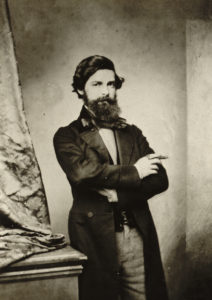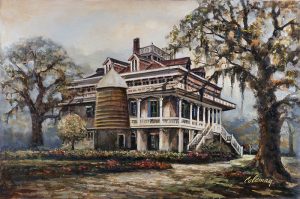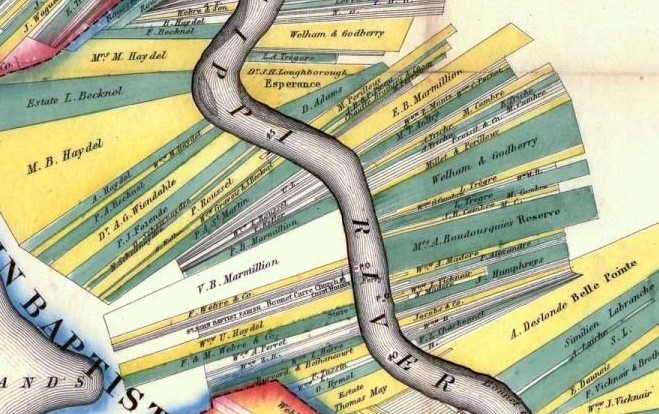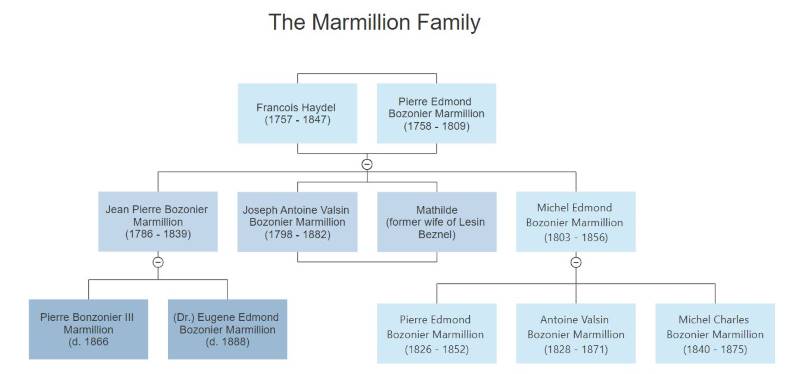Untangling the Marmillions, Part 1
On January 30, 1864, Harper’s Weekly published a set of accounts from formerly enslaved blacks from New Orleans. Emancipated by Benjamin Butler during the Federal occupation of the town, these individuals came forward to give their testimonies to the atrocities of their enslavement on the nearby plantations. It’s likely this was done to bolster fervor toward the cause of emancipation or to incite those who were on the fence about joining the Federal army and sway their decision to enlist. The below was adapted from the testimony of Wilson Chinn, who originally came from Woodford County, Kentucky, before his former enslaver Isaac Howard, sold him south.
“When 21 years old he was taken down the river and sold to Volsey B. Marmillion, a sugar planter about 45 miles above New Orleans. This man was accustomed to brand his Negroes, and Wilson has on his forehead the letters ‘V.B.M.’ Of the 210 slaves on this plantation 105 left at one time and came into the Union camp. Thirty of them had been branded like cattle with a hot iron, four of them on the forehead, and the others on the breast or arm.”[1]
Though the writer of the article misspelled the name of Wilson’s captor, the identity of his former enslaver is most likely Valsin Marmillion, reputedly one of the most prosperous sugarcane planters in St. John the Baptist Parish, Louisiana. The bigger question is, which one? In tackling a genealogical conundrum in this neighborhood, perhaps we can gain a better perspective on the social and economic relationships in the antebellum south and make sense of the influences plantation owners had over their community and enslaved.

Antoine Valsin Bozonier Marmillion was born to Michel Edmond Bozonier and Jeanne Antionette Marmillion in 1827. The Creole family purchased property along the Mississippi River in 1830 from Elisee Rilliuex, a Free Man of Color. It’s undoubted that the home was built by those held in bondage on the property between 1853 and 1856 until its completion. The elaborate carvings of the detailed trim and columns of the reception hall on the second floor of the home is attributed to the carpentry skills of a slave named John Trotter, the highest appraised on the estate’s records at $2,000.[2] Valsin’s older brother, Pierre Edmond Bozonier, was to inherit their father’s estate. Pierre, however, died in 1852. Valsin, an educated accountant by this time, was next in line to inherit, but he had no interest in owning a plantation. He and his German wife, Louise von Seybold, had dreams of moving to Europe. His ties in Louisiana and the sudden death of his father in 1856, shattered those dreams.

Valsin managed the plantation with his little brother, Michel Charles Bozonier who was too young to inherit at the time. The understanding was that Valsin would not stay permanently on the family property. Over the years, Valsin would make the plantation his own, letting his wife remodel the mansion to her liking. The estate was listed as “St. Frusquin” on the 1860-1861 crop reports, a name derived from the term “Sans Frusquin”, translated roughly as “without a cent in my pocket” which came from a joke Valsin told others regarding the extravagance of his mansion and of Louise’s decorating efforts. The name of the plantation later evolved to “San Francisco” by a later owner, adapted from the original name of the property so it would be easier to pronounce for English speakers. By 1861, Louisiana’s secession and the subsequent war put a halt on any efforts to rid himself of the responsibility and expenses associated with the estate.[3]
The other “Valsin B. Marmillion” is Joseph Antoine Valsin Bozonier Marmillion, the brother of Michel Edmond Bozonier and Valsin’s uncle. Less is known about this Marmillion, except that he also owned his own plantation across the Mississippi from his younger brother, and was significantly more wealthy in land and human property value. Here forward to avoid confusion, this Marmillion will be referred to as “Joseph Valsin.” He was listed on the 1860 census at the age of 62 with $80,000 in estate property and $120,000 in personal property with 145 enslaved.[4] His holdings were more significant than his brother’s estate on the other side of the river, listed at $75,000 for estate and personal property each, with 68 enslaved.[5] According to Norman’s chart of the lower Mississippi River, Joseph Valsin’s land was nearly twice the size of Michel Edmond’s.[6] Because of the size of Joseph Valsin’s estate, it may be assumed that Wilson Chinn’s account in Harper’s Weekly speaks of him, rather than the younger Valsin, but the numbers still don’t match up perfectly. Was he speaking collectively of all the enslaved on both estates, or was his estimation simply in error?

Another curious fact is that Norman’s Mississippi map was published in 1858 – two years after Michel Edmond’s death – and the land is not under Valsin or Charles’ names, but it’s under their father’s initials “E.B. Marmillion.” Nor are the two co-heirs listed on the 1860 slave schedules. Their father’s name is still listed. They are, however, listed in the 1860 general census and their deceased father is not. This may be due to the fact that Charles was too young to inherit and Valsin did not want to take full legal possession of the estate, so the plantation was held in a sort of trust until something could be decided, so the property and the enslaved were kept in Michel Edmond’s name, listed as “E.B. Marmillion” on the slave census and the map.
To add further confusion, Joseph Valsin is in the slave schedule and censuses, but listed as “Valsin Marmillion.” Both uncle and nephew went by the same name, with no indicator of who was who besides the fact that “Valsin Marmillion” is listed right next to “Pierre Marmillion” in the 1860 census and slave schedules due to their physical proximity to each other. This is not to be confused with Valsin’s older brother who died in 1852, who also went by “P.B. Marmillion” or “Pierre Marmillion.” This Pierre is their cousin, who inherited the plantation from his father, Jean Pierre Bozonier – Joseph Valsin and Michel Edmond’s other brother who passed in 1839. His property bordered that of Joseph Valsin’s and was valued at $25,000 for both land and property. This P.B Marmillion had a brother named Eugene Edmond Bozonier Marmillion, who is also referred to in newspapers as “E.B. Marmillion”, same as Valsin and Charles’ father. The only defining factor in discerning the two is that this E.B. was a doctor and lived in New Orleans, not St. John the Baptist Parish. A family tree has been made to clarify these relations.
To be continued in Part 2…
References
[1] From Harper’s Weekly, Saturday 30 January 1864.
[2] “The Enslaved.” n.d. Sanfranciscoplantation.Org. Accessed June 6, 2021. http://www.sanfranciscoplantation.org/the-enslaved/.
[3] “San Francisco Plantation History.” n.d. Sanfranciscoplantation.Org. Accessed June 6, 2021. http://www.sanfranciscoplantation.org/san-francisco-plantation-history/.
[4] The 1860 United States Federal Census, the Eighth Census of the United States, St. John the Baptist Parish, Louisiana, p. 58; Eighth Census of the United States 1860; Series Number: M653; Record Group: Records of the Bureau of the Census; Record Group Number: 29; National Archives, Washington D.C. pp. 24, 25.
[5] The 1860 United States Federal Census, the Eighth Census of the United States, St. John the Baptist Parish, Louisiana, p. 26; Eighth Census of the United States 1860; Series Number: M653; Record Group: Records of the Bureau of the Census; Record Group Number: 29; National Archives, Washington D.C. pp. 25.
[6] Marie Adrien Persac,, Benjamin Moore Norman, and J.H. Colton & Co, Norman’s chart of the lower Mississippi River, New Orleans, B. M. Norman, 1858. Map. https://www.loc.gov/item/78692178/.

Why this weird language? Enslaved X, instead of slave. Enslaver, instead of Slave Owner. It all reads rather clunkey and odd. But I guess times are slow for History writers.
Jon Tracey did an excellent post a while back concerning this sort of word choice and I happen to agree with the logic behind it. It’s definitely worth the read: https://emergingcivilwar.com/2021/06/02/a-reflection-on-historians-and-word-choice/
Thanks for the shoutout Sheritta!
“Enslaver” – That is an incorrect use of the word. An individual had no right to enslave anyone.
You may already be aware of this, but there are some CDV images of Wilson Chinn on the internet. We have a couple of them in our William Gladstone Collection at Pamplin Historical Park and the National Museum of the Civil War Soldier. The photographs show Chinn with a branded forehead and demonstrating several torture/control devices used on enslaved people.
My name is Jean-Maurice MARMILLION. I am a descendant of the Belgian branch that remained in Europe. The story of this sugar cane plantation fascinated me!
I’m fascinated as well, because I’m actually a descendant of the REAL DOCUMENTED ESTATE SUCCESSORS and the family name is Bougere, they left out the part where Valsin sold the Plantation and property to Francois Bougere, the one who changed the estate name to San Francisco. This was taking place while Louisiana was still France transitioning, just becoming a State. The family has an extremely fascinating history as there were actual war campaigns fought on the property.
My name is Charles Bozonier. I am a descendant of white rapists and African slaves and all I see here is atrocities and shame.
Hope all these devils are still burning ? ? ? ? in acid.
Ought to be simple to connect “Wilson” to the right Marmillion. What do the slave schedules show? As far the phony emotions displayed by the comments, the reality is the images of Wilson were created by Boston Abolitionists as propaganda tools and have nothing to do with reality.